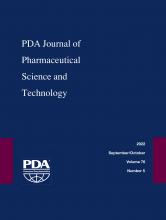Research ArticleTechnology/Application
Microbial Contamination in Water Systems
Fritz Röder and Tim Sandle
PDA Journal of Pharmaceutical Science and Technology September 2022, 76 (5) 434-443; DOI: https://doi.org/10.5731/pdajpst.2021.012636
Fritz Röder
1Merck Healthcare KGaA, Frankfurter Str. 250, 64293 Darmstadt, Germany; and
Tim Sandle
2Bio Products Laboratory Limited, Dagger Lane, Elstree Herts, WD6 3BX U.K.

References
- 1.↵
- 2.↵
- 3.↵Parenteral Drug Association Inc. Technical Report No. 69: Bioburden and Biofilm Management in Pharmaceutical Manufacturing Operations; Bethesda, MD, 2015.
- 4.↵
- Sandle T.
- 5.↵
- Joret J. C.,
- Mennecart V.,
- Robert C.,
- Compagnon B.,
- Cervantes P.
- 6.↵
- Wingender J.,
- Neu T. R.,
- Flemming H.-C.
- Wingender J.,
- Neu T. R.,
- Flemming H.-C.
- 7.↵
- Sandle T.
- 8.↵
- Favero M. S.,
- Carson L. A.,
- Bond W. W.,
- Petersen N. J.
- 9.↵
- Momba M. B.,
- Makala N.
- 10.↵
- 11.↵
- Sandle T.
- 12.↵
- Maquelin K.,
- Kirschner C.,
- Choo-Smith L.-P.,
- van den Braak N.,
- Endtz H. P.,
- Naumann D.,
- Puppels G. J.
- 13.↵
- 14.↵
- Giuliani G.,
- Ricevuti G.,
- Galoforo A.,
- Franzini M.
- 15.↵
- Sandle T.
- 16.↵
- Pelletier P. A.,
- du Moulin G. C.,
- Stottmeier K. D.
- 17.↵
- Ridgway H. F.,
- Olson B. H.
- 18.↵
- 19.↵
- 20.↵
- Tong C.,
- Hu H.,
- Chen G.,
- Li Z.,
- Li A.,
- Zhang J.
- 21.↵
- Cai Y.,
- Sun T.,
- Li G.,
- An T.
- 22.↵
- Sandle T.
- 23.↵Health Canada. Guidelines for Canadian Drinking Water Quality: Guideline Technical Document: Bacterial Waterborne Pathogens. Current and Emerging Organisms of Concern. Health Canada: Ottawa, ON, Canada, 2006.
- 24.↵
- Levy R. V.,
- Cheetham R. D.,
- Davis J.,
- Winer G.,
- Hart F. L.
- 25.↵
- Berry D.,
- Xi C.,
- Raskin L.
- 26.↵
- Méndez-Vilas A.
- Yurudu N. O. S.
- 27.↵
- 28.↵
- Kuchta J. M.,
- States S. J.,
- McGlaughlin J. E.,
- Overmeyer J. H.,
- Wadowsky R. M.,
- McNamara A. M.,
- Wolford R. S.,
- Yee R. B.
- 29.↵European Medicines Agency. EMA Questions and Answers on Production of Water for Injections by Non-Distillation Methods—Reverse Osmosis and Biofilms and Control Strategies. EMA Web site. https://www.ema.europa.eu/en/documents/other/questions-answers-production-water-injections-non-distillation-methods-reverse-osmosis-biofilms_en.pdf (accessed October 2, 2021).
- 30.↵
- Schäefer A. I.,
- Fane A. G.
- Cohen Y.,
- Choi J. Y.,
- Rahardianto A.
- 31.↵U.S. Pharmacopeial Convention. General Chapter <1231>: Water for Pharmaceutical Purposes. In USP 42—NF 37, USP: Rockville, MD, 2019.
- 32.
- Röder F.
In This Issue
PDA Journal of Pharmaceutical Science and Technology
Vol. 76, Issue 5
September/October 2022
Microbial Contamination in Water Systems
Fritz Röder, Tim Sandle
PDA Journal of Pharmaceutical Science and Technology Sep 2022, 76 (5) 434-443; DOI: 10.5731/pdajpst.2021.012636
Jump to section
- Article
- Abstract
- Microbial Ecology of Pharmaceutical Water Systems
- Antimicrobial Water Treatment
- Ozone
- Chlorine
- Chloramines
- UV Light
- Heat
- Protective Mechanisms
- Implementation of a Sanitization Concept for a Water System
- Reliable Operation of Water Systems
- In Case of Microbial Proliferation inside the System
- Summary
- Conflict of Interest Declaration
- References
- Figures & Data
- References
- Info & Metrics
Related Articles
- No related articles found.
Cited By...
- No citing articles found.





